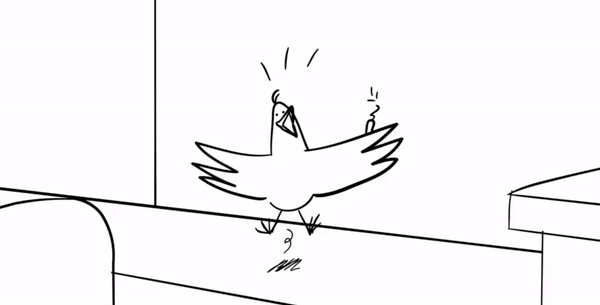
Fowl Heist
Thanks to my friend and fellow Columbia College Chicago alum (@paint_sponge, seriously thank you) who worked on our APS film “Cupid in Training,” I had the opportunity to contribute to the wonderful 3D Animated Indie film “Fowl Heist.” My role as a storyboard artist was to create scene visuals for the film based on a written script (I was a part of a team of other board artists).
This wasn’t some group project for school anymore. Because it had already been underway for a couple months, I wanted to take this project seriously and be professional like I would for any employer. For example, even though all meetings were optional I came to treat them as mandatory.
All communication for this project took place remote over Discord, primarily in one server dedicated to the production. Notion and Google Drive were used for production scheduling and file sharing/management respectively. Weekly meetings kept everyone on the same page.
Scene #1
For my first scene, I became reacquainted with Storyboard Pro and quickly mastered keybinds. Aside from that, this first scene was full of lessons that I found useful, such as:
Storyboard drawings do not need to be detailed on the first pass. I spent too much time getting proportions right and coloring in with greytones.
If you don't know enough, communicate. I didn't have enough information about the environment, so I brought this up with the director who provided me with a rough grey-boxing of the scene, which ended up being very helpful for camera placement.
Know the scope. I did not need to time-out shots nor did I need to do unnecessary camera moves, since again this was a rough pass and I’m not the animatic editor.
Feedback from the director for this scene involved adjusting some action order, camera zoom, some character expression, and changing one of the main props across multiple panels.
Scene #2
The second scene, mostly action, was stronger because of lessons learned from the first scene. I also researched professional storyboards and as a result, I added in impact frames, dynamic action, and foreshortening.
Feedback for this scene involved additional impact frames, some flight path continuity adjustment across several panels, landing position adjustment with additional prop interaction, and embellishing expressions.
Scene #3
My third scene was complicated because of many characters interacting dynamically. I am proud of this board's depiction of character interactions because I included more varied camera angles, like fisheye. Drawings began to pop more. It’s not every day you have to think about how a bunch of flamingos can take down a full grown man in a flashy manner.
Feedback for this scene involved minor action order adjustment, confrontation time reduction, hostage interaction time increase, prop establishment, and a character exit.
Scene #4
Right after I finished my most of my revisions and was waiting for the OK on the final cleanup pass, our producer asked me to do revisions on an additional scene, since I believe one or more of our boarders had to drop out of the production. I enthusiastically agreed, even though I knew I practically needed to do the whole scene over from scratch. I felt like I was really getting the hang of boarding and wanted to go all out.
This final scene felt like a long one, with lots of consideration to the interior environment (in addition to some well crafted notes from our story lead) that needed to be kept in mind. I ended up being most proud of this scene, because it put to use almost everything I came to figure out in my previous scenes:
dynamic angles
staging
continuity
foreshortening
a whole lot of creative problem solving
I don’t think I was able to get some of the perspective right in a few places but it’s certainly close enough for board purposes. While this scene wasn’t reviewed in a meeting like the others, it was approved straight away with no revisions.
After the final pass, our producer continued to ask me to pick up slack on board revisions needed during the animatic creation process. I was happy to do that. Once my role as a storyboarder came to an end, I consulted with the director about any similar positions I could step into to continue helping with production. They had a vision for 2D subtitles that would help enhance the impact of certain scenes, so more on that once the process comes to pass.

